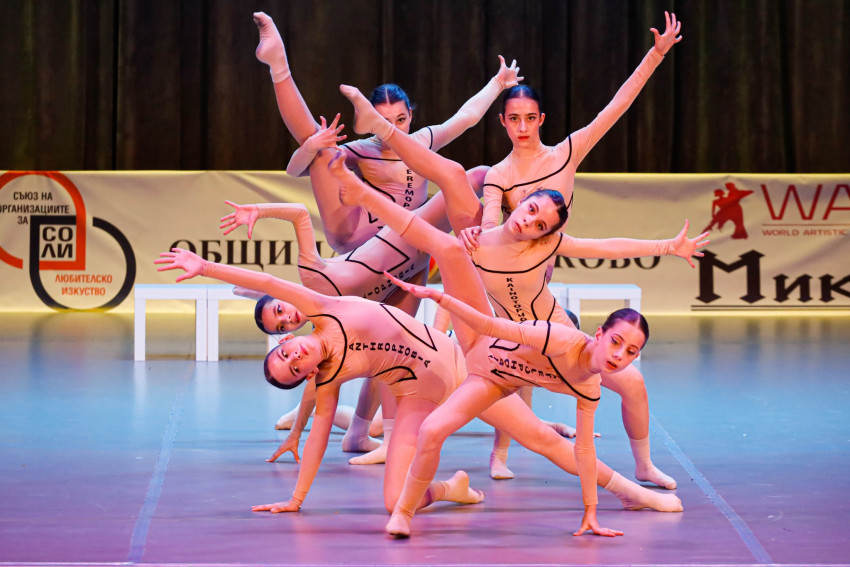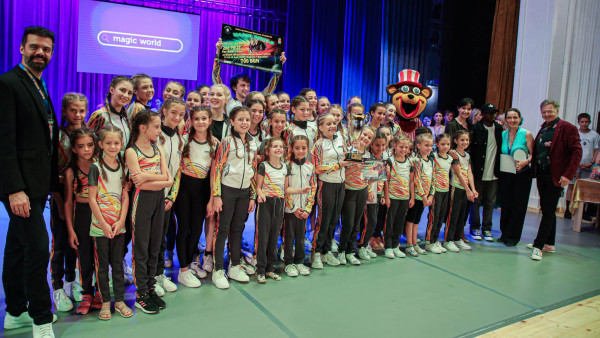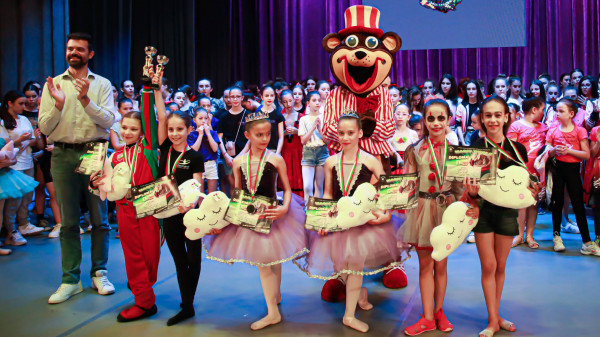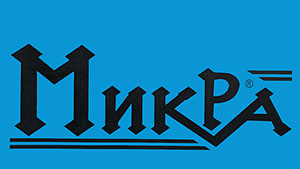21st EDITION OF
"MAGIC WORLD"
INTERNATIONAL DANCE FESTIVAL
HASKOVO, BULGARIA
20-21-22 MARCH, 2026

magic



LOCATION


about us
International Dance Festival "Magical World"
Over 30 dance styles in three days, an authoritative professional international jury, a rich prize fund, scholarships, the best schools on our stages, a friendly atmosphere and lots of happy emotions - this is a "Magic World"!
Current
-
0+
Participants
-
0+
Stages
-
0+
Awards
JUDGES 2025

Our professional team of judge stars:
Chiara Gagliardo is a Principal dancer at Balletto Di Siena
She graduated at Ateneo della Danza under the direction of Marco Batti. After a season in Balletto di Siena as member of the Corps de ballet she attended two years of specialization at Joffrey Ballet School and meanwhile working at XAOC Contemporary Ballet - New York, USA.
Chiara Gagliardo
Italy
Francois is an Ambassador for the World Artistic Dance Federation (WADF) and official judge, he is a member of the World dance Council and President of the WAPA (World Association of Performing Arts), chapter Switzerland. More than 30 years he is working with dancing. As a successful professional dancer, competitor and now trainer, coach and international judge he dedicates his life to the art of dance.
Francois organized two World championships and many national competitions in couple dances. But his career as a dancer brought him mainly around the world in many theatre, dance companies and cruise lines.
As a multilingual professional he is involved in several dance studios in Asia and Europe and gives workshops around the world in couple and stage dance, he is a partner of “The Robert Fashion Dance – Italy”. He brought more than 40 couples and individual dancers to World, European and National titles.
Francois Bernard
Switzerland
Giuseppe Giacalone is a Principal dancer at Balletto Di Siena. He graduated at Ateneo della Danza under the direction of Marco Batti and joined Balletto di Siena ad Company member the following season, after having completed two years of apprenticeship. He obtained the dance teacher diploma, recognized in Europe. Currently, he is faculty member of Ateneo della Danza Professional Training Program, as Ballet, Repertoire, Male Technique and Pas de Deux teacher. He is guest teacher in many events, workshops, stages, master classes and competitions as a jury.
Giuseppe Giacalone
Italy
Marina is a choreographer, dancer, and pedagogue and judge with extensive experience on both national and international dance scenes. She has been dedicated to dance since the age of seven and has trained in Serbia and abroad, working with leading experts in the field. As an active dancer and choreographer at the Belgrade Dance Center and Beat Street Dance Company, she has won multiple awards at prestigious festivals and competitions. A member of the Association of Modern Dancers and Choreographers in Serbia, she is committed to advancing contemporary dance. Beyond her artistic work, Marina is involved in socially responsible projects focusing on inclusion, and support for underprivileged children. She is also one of the organizers of the Catch the Rhythm festival and the founder of the dance group Enigma, continuously exploring new artistic expressions.
Marina Maksimovich
Serbia
Filippo Del Sal is a Principal dancer at Balletto di Siena. He graduated at Teatro alla Scala ballet academy, and worked in many companies before joining Balletto di Siena. He achieved a master’s degree in Literature, Art, Music and Performance and the dance teacher diploma, recognized in Europe. Currently, he is also faculty member of Ateneo della Danza Professional Training Program, as Ballet, Repertoire, Character Dances, History of Ballet and Music teacher. He is guest teacher in many events, workshops, stages, master classes and competitions as jury.
Filippo Del Sal
Italy
Teacher and choreographer at Academy Talent Show. He works with Academy RAI 1 and Academy RAI 2. He is famous with participating in Dance n Hold Jim TV, Ti Lascio una canzonne RAI 1.
Phil has done the trailer’s choreography for Fame movie. He also participates in many videos of world famous singers such like Justin Timberlake (Summer Love), Craig David (Hot Stuff, Whats yr Flava), Mariah Carey (It’s like that, Shake it off, We belong), Se7en (Crazy), Britney Spears, Back Street Boys, Jeanette Biederman, Brandy, Outcast, Wu Tang Clan and many others. He works with them in their tours and concerts as a choreographer, dancer and supporting actor. Phil is working with Nike, Adidas, Reebok, Puma, Freddy, BMW, Opel, Rifle jeans, Oneil, Interjeans, Fibbo, etc. He works in Italy very often.
Lil Phil
Belgium
Founder and Director of Balletto Di Siena, Founder and Artistic Director of the Professional Education course in a.s.d Ateneo della Danza where he teaches Ballet, Contemporary, Contact, Duos, Pointe Technique, ABT Affiliate Teacher. Marco Batti has studied dance methodology at The Royal Ballet School in London, studied and certified by Vaganova Academy of S. Petersburg, certified teacher in Gyrotonic Expansion System, also graduated the University of Florence- Medicine and Surgery, Sports and Physical Sciences department. Marco has also studied in the following schools - The Ailey School (Horton method), The Martha Graham School, Limon Institute, The Merce Cunningam Studio, Paul Taylor School, Isadora Duncan Foundation, Studio Maestro, and Suzanna Marek. Marco is a guest teacher in USA, Cuba, Spain, England, Bosnia, France, and Italy and again in Bulgaria at MAGIC WORLD International Dance Festival. Marco has a numerous awards as a Best Choreographer at different competitions, also in University Association UNIXTUTTI of Siena, First Italian Teacher to graduate from the American Ballet Theater ® National Training Curriculum, member of CID-UNESCO. He registers his own methods – 1) Biomechanics of Dance in Water Method, 2) The CAVALCARDANZANDO Method: a playing – educative path between horse riding and dance; 3) C.J.M.B. Method (Contemporary Jazz Marco Batti).
Marco Batti
Italy
Assoc. Prof. Roslana Moravenova, Ph.D - She teaches at the Department of Choreography at the Academy of Music, Dance and Fine Arts Prof. Asen Diamandiev, Plovdiv in the disciplines: Choreographic Composition, Choreographic Directing and Dance Performance, a former graduate of the National team in rhythmic gymnastics.
Assoc. Prof. Moravenova has close interests, experience and scientific work in the study of Bulgarian dance folklore, its dramatic development, the relationship between sport and dance and various types of dance arts. She has published numerous scientific works and monographs related to the relationship between dance arts, the role of ballet and folklore in the interpretation of dance stage productions and management specifics in choreographic productions.
Choreographs and directs significant cultural events related to anniversaries and annual holidays of AMDFA, official openings of the World Cup of Rhythmic Gymnastics, Sofia in 2012 and 2022; Director of artistic lighting of famous cultural events, including concert performances of Prof. Daniela Dzheneva and annual concerts of the Department of Choreography of AMDFA. Her experience is valuable not only in the country but also in other countries.
Roslana Moravenova
Bulgaria
He is a graduated dancer and certified teacher of the National Ballet School of Cuba. Mr. d'Alton was a dancer with the National Ballet of Cuba and a Principal Dancer with Orlando Ballet. He is a three time Outstanding Choreographer of Youth America Grand Prix and has been a Guest Teacher at leading organizations around the world including the Royal Ballet School - Covent Garden, Czech National Ballet (Národní Divadlo - Prague), Canada's Royal Winnipeg Ballet, Norwegian National Ballet School, Vienna State Opera Ballet School, Polish National Ballet, Tanzcompany Innsbruck, the National Moravian-Silesian Ballet, Dresden Semperoper Ballett, Balletto di Siena, and the Lithuania National Opera & Ballet Theatre, among many others. Mr. d'Alton's students have great successes in prestigious dance schools, academies and contests.
Richard d'Alton
Ireland
Doctor of theater studies and theater arts, specialized in acting at the Royal Shakespeare Theater, Stratford-upon-Avon, Great Britain. He graduated from the National Academy of Theater and Film Arts "Kr. Sarafov", Sofia. He specialized at Oriel College, Oxford University, Great Britain. He also graduated from Sofia University "St. Kliment Ohridski" with a degree in English Philology. Dragunchev is a director, philologist and translator, expert evaluator and consultant. Executive Director of the National Fund "Culture" under the Ministry of Culture of the Republic of Bulgaria for the period 2022-2024. He was a senior expert in the Office of the President of the Republic of Bulgaria 1999-2001, an associate at the Ministry of Foreign Affairs of the Republic of Bulgaria in 1996. A teacher at the National Academy of Theatre and Film Arts (NATFIZ) for 3rd year students of the ACT program. Sava Dragunchev Jr. is a winner of numerous prestigious awards, directed numerous plays and performances, a delegate, lecturer and chairman of significant commissions in the field of art.
Sava Dragunchev, PhD
Bulgaria
Máté Pék has obtained his masters degree from the Hungarian Dance Academy as a dancer and teacher of modern couple and solo dances. Throughout the last 12 years, he became World and European Champion with his partner, Edit Lilla Nagy in several world organizations, like World Latin Dance Cup, World Salsa Summit, Euroson Latino, WADF, World DanceSport Federation and many more. He is the Hungarian Champion of Caribbean Dances consecutively for 6 years. He has been teaching with his partner in Budapest, Hungary under their own dance studio.
Mate Pek
Hungary
Edit Lilla Nagy has graduated from the Hungarian Dance Academy with masters degree. Specialized in ballroom, caribbean and choreograped couple and solo dances. She competed in several world associations like World Salsa Summit, World Latin Dance Cup, World DanceSport Federation, Euroson Latino, WADF and many more,where she recieved various World and European Champion titles. She is the Hungarian Champion of Caribbean Dances consecutively for 6 years. She has been teaching and coaching soloists and couples with her partner, Mate Pek in Budapest, Hungary.
Edit Lila Nagy
Hungary
Choreographer, graduated from the Institute of Music and Choreography in Sofia, majoring in Bulgarian folk dances, worked as a choreographer for the ensemble for folk songs and dances "Pretty Thrace”, Haskovo. He teaches History of Dance Art and Bulgarian Folk Dances at the Institute for Cultural and Educational Personnel, Haskovo. Founder and leader of the Children's Dance Ensemble "Yuzhnyache" for 38 years. He is currently the artistic director of the dance ensemble "Yuzhnyatsi" (Southerners) at "Peyo Yavorov -1982" Community Center, Haskovo.
Vasko Dimov is an author and co-author of dance choreographies for children and adults. He has realized his productions in Lvov - Ukraine and Tashkent - Uzbekistan. He is a creator of mass dance compositions on the occasion of significant dates and celebrations. Multiple appearances on international stages and winner of prestigious awards: Gold Badge of the All-Union Council of Trade Unions of Uzbekistan; Gold Medal from San Diego - California; Golden key from the city of Ismailia - Arab Republic of Egypt.
He is a three-time winner of the Plaque of the Municipality of Haskovo; twice holder of the Honorary Badge of the District Governor of Haskovo District; Silver and Gold Lyre of the Union of Music and Dance Figures in Bulgaria. Mr. Dimov is awarded by the Ministry of Culture with a Diploma and Honorary Badge "Seal of Tsar Simeon the Great" - silver for his contribution to the development and promotion of Bulgarian culture and art, Honorary citizen of Haskovo, awarded with the Lifetime achievement award of SOLI.
Vasko Dimov
Bulgaria
For the best

Gallery

Partners






































